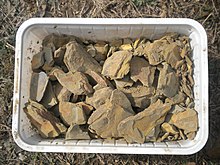Fuller's earth


Fuller's earth is any clay material that has the capability to decolorize oil or other liquids without the use of harsh chemical treatment.[1][2] Fuller's earth typically consists of palygorskite (attapulgite) or bentonite.[1]
Modern uses of fuller's earth include as absorbents for oil, grease, and animal waste (cat litter) and as a carrier for pesticides and fertilizers. Minor uses include filtering, clarifying, and decolorizing; active and inactive ingredient in beauty products; and as a filler in paint, plaster, adhesives, and pharmaceuticals.[1] It also has a number of uses in the film industry and on stage.
Etymology[]
The English name reflects the historic use of the material for cleaning or fulling wool by textile workers called "fullers".[1][2][3] In past centuries, fullers kneaded fuller's earth and water into woollen cloth to absorb lanolin, oils, and other greasy impurities as part of the cloth finishing process.
The original spelling was without an apostrophe (see 1915 image), but the apostrophe became more common in the 19th century, both before or after the s. Fuller's earth is the most common spelling today, but both fullers earth and fullers' earth have been widely used.[4]
Fuller's earth is also known by the following other names:
- "Bleaching clay",[5] probably because fulling whitened the cloth.
- "Whitening clay", particularly when used to treat facial pigmentation, such as melasma.
- Multani mitti (Hindustani: ملتانی مٹّی, मुल्तानी मिट्टी; transl. 'clay of Multan'), widely used in the Indian subcontinent in cosmetics.[6]
Occurrence and composition[]
Fuller's earth consists primarily of hydrous aluminum silicates (clay minerals) of varying composition.[1] Common components are montmorillonite, kaolinite, and attapulgite. Small amounts of other minerals may be present in fuller's earth deposits, including calcite, dolomite, and quartz. In some localities fuller's earth refers to calcium bentonite, which is altered volcanic ash composed mostly of montmorillonite.[2][7]
In 2005, the United States was the largest producer of fuller's earth with an almost 70% world share followed at a distance by Japan and Mexico. In the United States fuller's earth is typically derived from deposits of volcanic ash of Cretaceous age and younger (glacial clays do not form fuller's earth).[1][5] Fuller's earth deposits have been mined in 24 states.[1] The first discovery of fuller's earth in the United States was near Quincy, Florida, in 1893; previously it was imported from England. In 1939 mines near Quincy produced half the U.S. production.[8]
In the United Kingdom, fuller's earth occurs mainly in England. It has been mined in the Lower Greensand Group and the Vale of White Horse, Oxfordshire. The Combe Hay Mine was a fuller's earth mine operating to the south of Bath, Somerset, until 1979.[9] Other sites south of Bath included Frome, Lonsdale, Englishcombe, Tucking Mill, and Duncorn Hill.[10] Although these sites had been used since Roman times, William Smith developed new methods for the identification of deposits of fuller's earth to the south of Bath.[11] Other English sources include a mine near Redhill, Surrey (worked until 2000), and Woburn, Bedfordshire, where production ceased in 2004.[12]
Hills, cliffs, and slopes that contain fuller's earth can be unstable, since this material can be thixotropic when saturated by heavy rainfall.
Historical significance[]
Fulling is an important step in the production of woolen garments, and can be traced back to ancient times. Cuneiform texts from Mesopotamia mention a raw material, im-bab-bár (Akkadian: